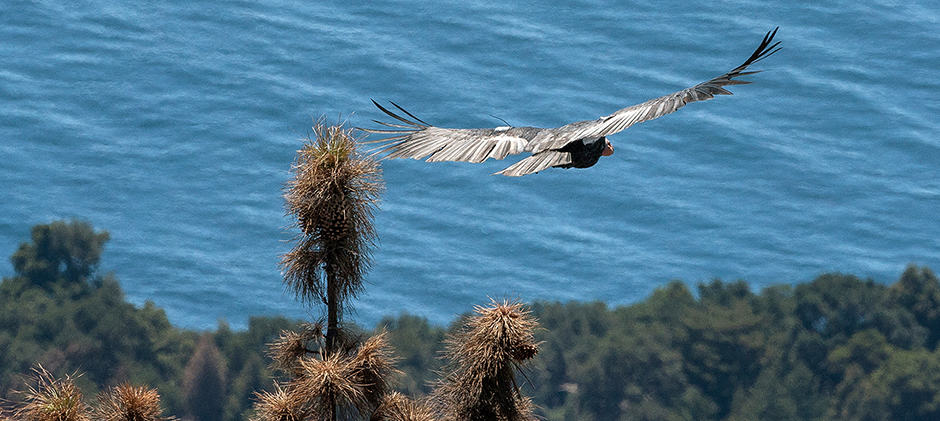Share this article
Coastal condors face risks from legacy chemicals
Chemicals long-banned in the U.S. like DDT and PCBs continue to pose a risk to California condors, researchers found, as the critically endangered raptors feed on contaminated marine mammals along the California coast.
Researchers who conducted a study published in Environmental Science & Technology found that coastal condors have higher levels of contaminants in their systems than inland condors. The team also found that marine mammals in Southern California, where industrial chemicals were once dumped, have higher contaminant levels than marine mammals to the south, in Baja California, Mexico.
That is good news for Mexico’s growing population of California condors (Gymnogyps californianus) on the peninsula, but it raises concerns about threats to California’s population, which is already facing another severe threat—lead poisoning. Condors ingest lead when they eat carcasses of animals that had been shot with lead ammunition.
“This is an unfortunate situation generally for condors,” said study co-author Nathan Dodder, an analytical chemist and research scientist in the School of Public Health at SDSU and the SDSU Research Foundation.
Researchers found that marine mammals stranded on the California coast harbor had relatively high levels of halogenated organic contaminants, or HOCs, which include the pesticide DDT and industrial chemicals known as PBCs. They detected more than 400 contaminants in samples taken from stranded marine mammals that California condors may feed on.
On the California coast, the marine mammals had an estimated seven times more DDT and 3.5 times more PCBs than those in Baja California. The researchers also detected lesser-studied compounds. One group of compounds was estimated to be 148 times more abundant in California marine mammals compared to those in Baja California.
An average of 32 contaminants were detected in coastal condor blood samples, compared to only eight in inland condors. DDT and PCBs were estimated to be seven times and 40 times more abundant, respectively, in coastal condors than inland condors. A contaminant known as TCPM was abundant in coastal condors but completely absent in inland condors. Another contaminant, TCPMOH, was about 56 times more abundant in coastal condors than in inland condors. Researchers say this study was the first to find those compounds in condors.
“This type of research is really useful to manage recovery and how we’re going to keep reintroducing condors throughout their range,” said co-author Ignacio “Nacho” Vilchis, associate director of recovery ecology at the San Diego Zoo Wildlife Alliance.
The waters off the coast of Southern California were once a dumping area for industrial chemicals. Although they have long been banned, these so-called legacy chemicals can remain in ecosystems, bioaccumulating up the food web until they reach marine mammals like whales and sea lions. Since marine mammals travel up and down the coast, they spread the contaminants to coastal condors in Central California, where the birds are being reintroduced.
The chemicals can cause egg thinning, most famously causing sharp declines in bald eagles (Haliaeetus leucocephalus) and other raptors. While past research has found evidence of egg thinning in California condors, Vilchis said, it does not appear to be affecting their reproductive success.
The research points to the benefits of recovering the Baja California population of condors, Vilchis said, where ocean contaminants appear to be less of a concern and lead poisoning seems to be waning.
California condors were nearly extinct a few decades ago, and their population has been slowly recovering thanks to breeding and reintroduction efforts. About 335 free-flying birds now exist in the wild. Lead poisoning remains the primary cause of death for inland California condors. Coastal habitats likely present lower risk of exposure to lead, but these contaminants raise new questions.
“At the end of the day, these legacy chemicals are in the ocean,” Vilchis said. “We want to go and see what else we can learn and what it will take to clean it up. My hope is it doesn’t affect the condors as much as it could.”
Header Image: Coastal populations of California condors may be at risk of contamination from legacy chemicals like DDT and PCBs. Credit: Courtesy San Diego Zoo Wildlife Alliance








